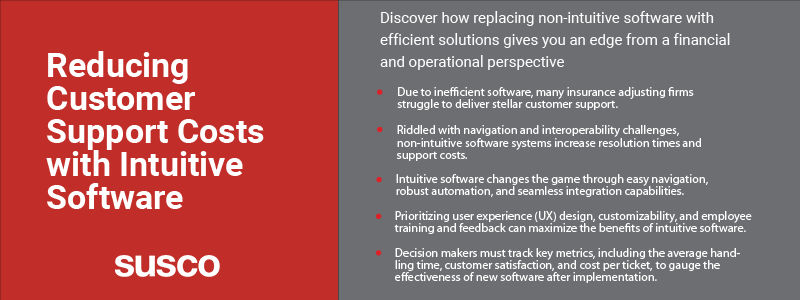Discover how replacing non-intuitive software with efficient solutions gives you an edge from a financial and operational perspective

In the world of insurance adjusting, time is money. Yet, all too often, inefficient software drains both, leaving firms scrambling to keep their heads above the water and meet customer expectations.
Luckily, the situation isn’t all doom and gloom. Insurance adjusting firms’ decision makers who struggle with high customer support costs can leverage intuitive software to streamline operations, reduce costs, and enhance service quality. Read on to learn more.
Understanding the impact of software on customer support
It’s beneficial to think of a software’s intuitiveness to understand its impact on customer support.
Generally speaking, software is either intuitive or non-intuitive.
Non-intuitive software typically leads to longer resolution times and increased support costs for some reasons.
First, navigation isn’t straightforward, and it takes employees some getting used to before they master the software. Even then, they may still find it challenging to access and update data, communicate with customers, find relevant reports with minimal searching or clicking, or manage and process documents. This creates a situation where employees are constantly bogged down in figuring out the software instead of actually performing tasks.
Additionally, non-intuitive software systems often lack interoperability, which can be problematic when your organization uses different modules and functionalities and needs seamless communication and data flow between departments. Poor interoperability creates data silos, making it hard for employees to share information, coordinate efforts, and deliver consistency. This ultimately translates to higher customer support costs as tasks take longer.
Intuitive systems enhance financial outcomes and operational efficiency. They provide users with a clean, easy-to-navigate interface, seamlessly guiding them through tasks with minimal effort. They also have robust automation capabilities and provide seamless integration with existing systems to expedite issue resolution and reduce workloads.
Key features of intuitive software for customer support
Intuitive insurance software transcends basic functionality, blending human-centered UX design with simplicity, automation, and robust integration capabilities. Here are the key elements of intuitive software that are pivotal in shaping customer support costs and operations.
Easy navigation
Intuitive software allows users to find the desired function or information naturally through instinct rather than instruction. It uses a self-explanatory interface that arranges on-screen elements logically, guiding users through tasks efficiently and easily. This means that employees don’t need to go through extensive training sessions to understand the software or second-guess their next move every time they’re performing tasks.
Robust automation
Intuitive software automates tasks and workflows, helping reduce paperwork and data entry, eliminate manual errors, improve operational efficiency and employee productivity, and free up resources for more strategic initiatives. This optimizes resource utilization, leading to quicker issue resolution. At the same time, it also yields significant cost savings, helping improve the organization’s overall financial performance.
Strong integration capabilities
Intuitive software readily interfaces with other systems, allowing the organization’s IT infrastructure to operate as one unit. It connects with the services and tools you already use and lets you adopt new ones without disrupting existing workflows.
Below, we explore best practices for transitioning to intuitive software solutions.
Strategies for implementing intuitive software solutions
Transitioning to intuitive software is not merely a technological upgrade—it’s a strategic investment in customer satisfaction. When embarking on this journey, insurance adjusting firms must prioritize user experience (UX) design from the start, ensuring that every interaction with the software is seamless. Additionally, decision-makers must emphasize that the development team tailors the software to the organization’s needs and workflows.
Employee training can also help maximize the new software’s benefits. By providing comprehensive training programs and soliciting feedback from frontline staff, insurance adjusting firms can ensure smooth adoption and ongoing optimization of the software. After all, the people behind the screens ultimately drive the success of customer support initiatives.
The implementation process isn’t the end of the road, though. You’ll need to measure the software’s return on investment (ROI) and make changes where necessary.
Measuring the impact on support costs and efficiency
As the old saying goes, what gets measured gets managed. To gauge the effectiveness of intuitive software, insurance adjusting firms must employ a range of metrics to track performance and identify areas for improvement. Average handling time, customer satisfaction scores, and cost per ticket are among the key indicators that offer insights into the efficacy of support operations.
- Average handling time: Track the average time it takes to handle support requests, including time spent talking with customers, resolving issues, and conducting follow-ups. Doing so provides unique insights into the value added by the new software. Generally, the more efficient the software, the lower the average handling time and support costs.
- Customer satisfaction scores: Ask customers how satisfied they are with services to learn firsthand about their experience. Consider using surveys to gather feedback and identify what’s working well, what needs to improve, and how customers feel about changes. Remember to track customer satisfaction at various touch points for a holistic view of customers’ experiences and to find and mitigate potential bottlenecks more easily.
- Cost per ticket: Track the average cost of resolving support tickets to gauge the financial impact of implementing the software. If the software reduces the ticket cost over time, it’s a successful investment. However, if it does little to reduce costs, change is needed.
Streamlining customer support for business success
The undeniable influence of intuitive software in shaping the future of the insurance adjusting business is no longer a debate. And it will only increase as customer support technologies and practices evolve. As this trend unfolds, forward-thinking companies that adopt intuitive software early will have the upper hand in terms of service quality and cost reduction.
Don’t be left behind. Streamline customer support for business success with intuitive software from Susco. Contact our experts today to help evolve your capabilities.